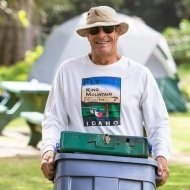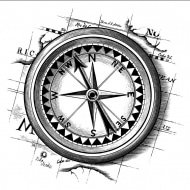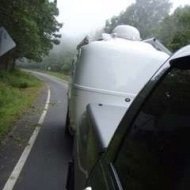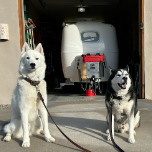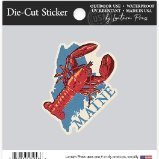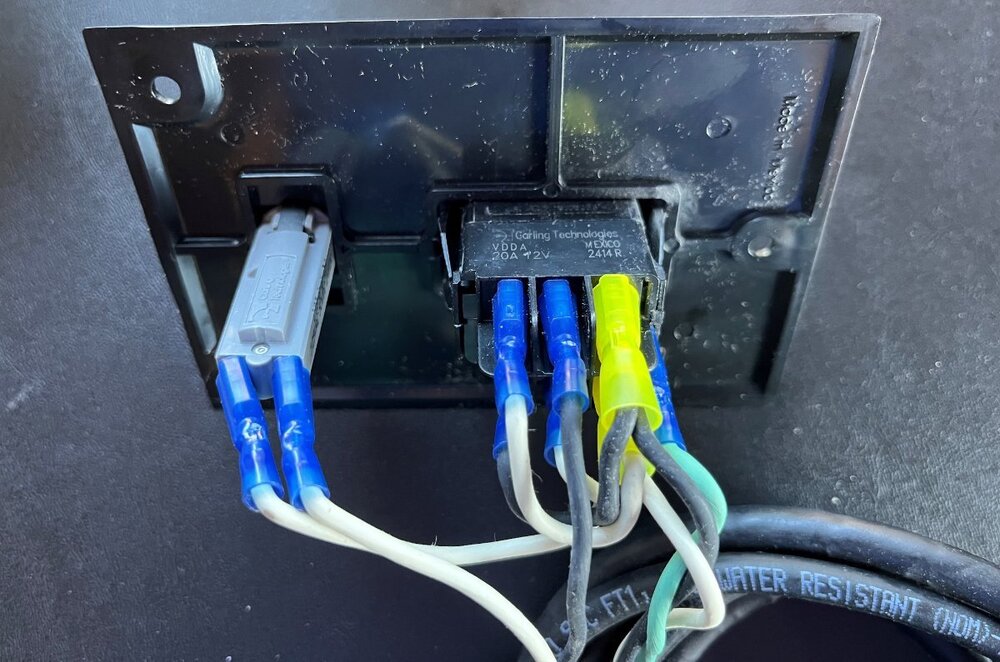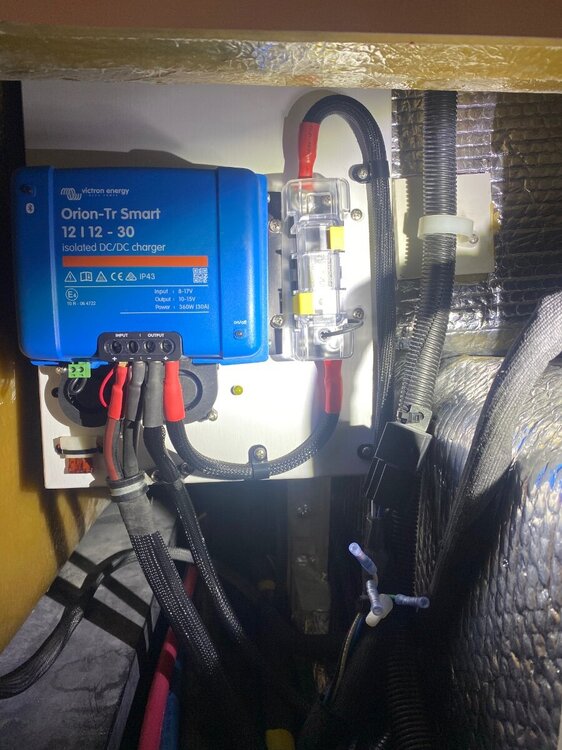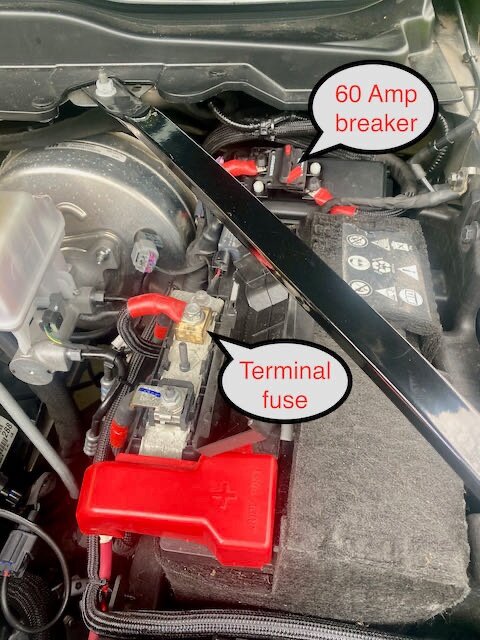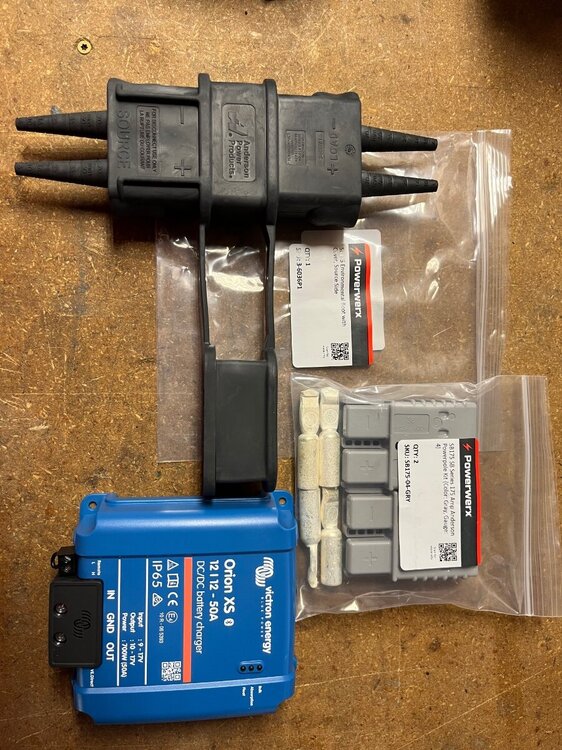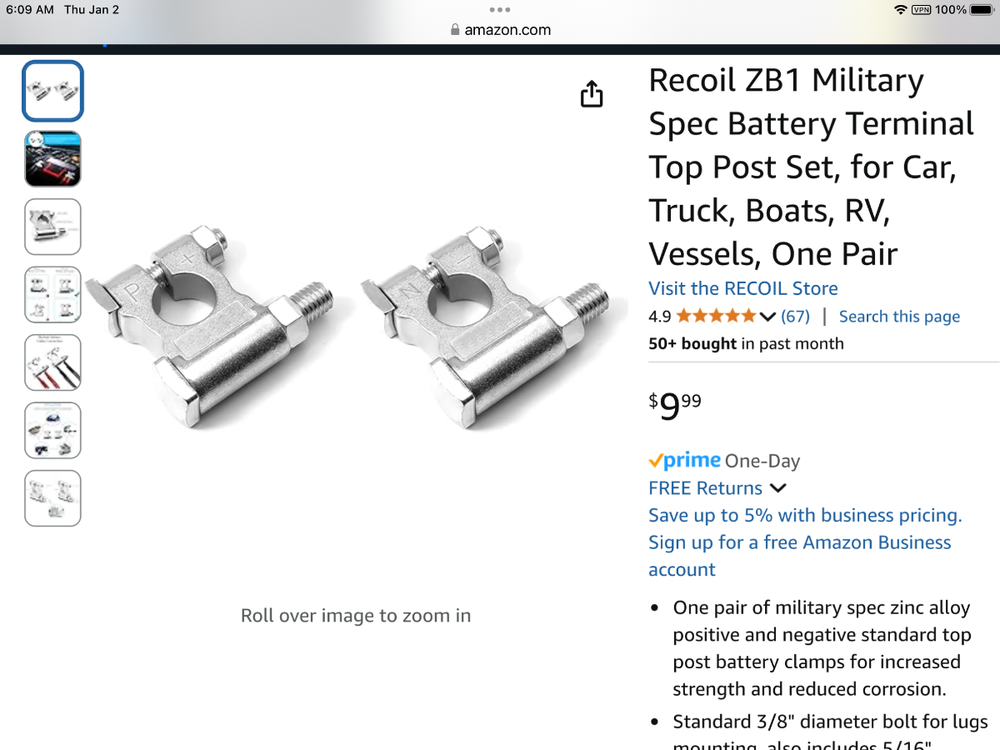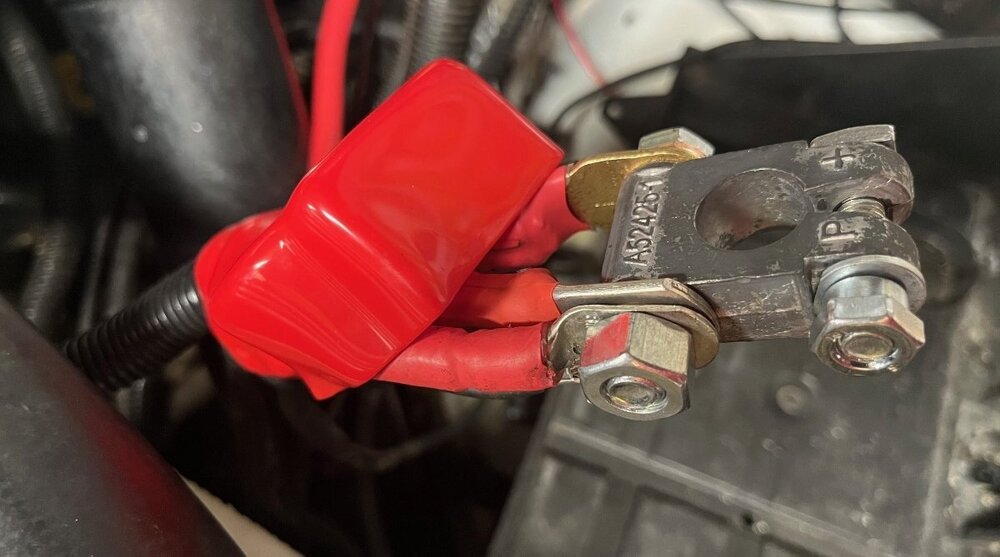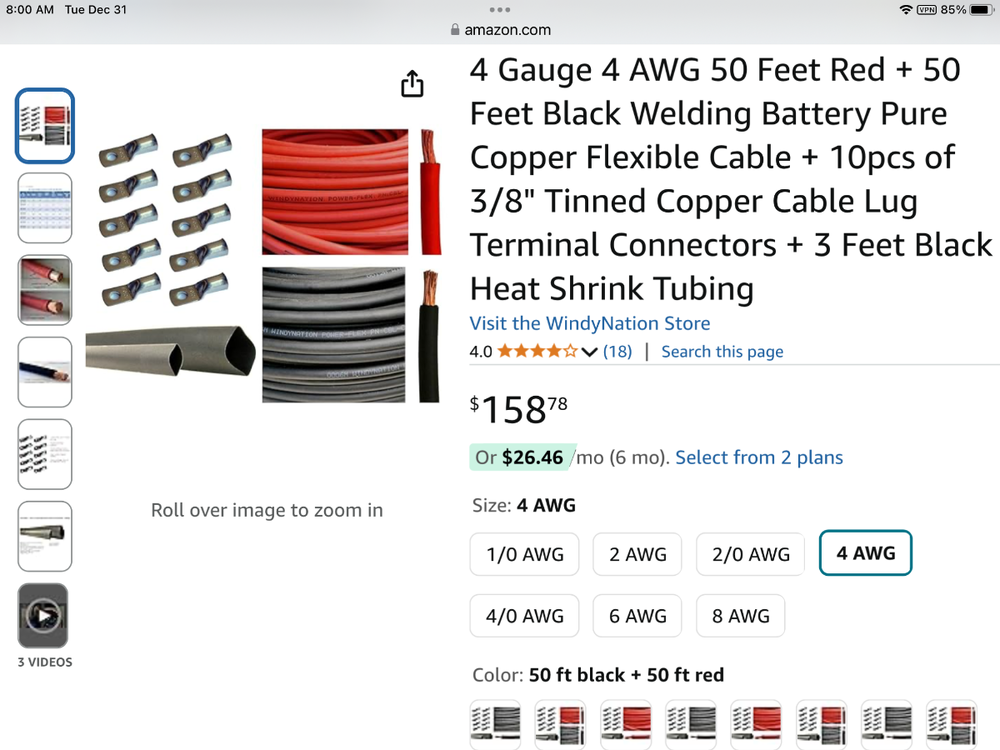Leaderboard
Popular Content
Showing content with the highest reputation on 01/29/2025 in all areas
-
Upon checking, I discovered that a re-certified tank is only good for an additional five years.6 points
-
Yes there is a pin or foot at this end which acts as a pivot. They demonstrated on a concrete slab at the rally, so it will work on various surfaces. The frame folds up quite compact, sort of like a folding camp chair. Coy told me yesterday the company that makes the solar panel is developing a light weight panel that folds in the middle that will weigh about 11 lbs. This should greatly improve the portability of the whole system. The panels are the same brand that Oliver installs on the new campers.5 points
-
Y @Steve-Gwenne, you will enjoy a very special relationship with the grandchildren. I know I do. My little grandson is my little buddy. I have the joy of spending 4 days a week, sometimes 5, watching him grow and learn, and play with me. I count myself lucky to be able to experience these days. I'm sure you feel the same. My daughter spent her days with my parents until she was three, and still has so many wonderful memories of those days. Who knows, you may even find that the grandkids enjoy the Ollie as a playhouse, and an early introduction to camping, even if it's just in the driveway, and daytime. (Our daughter loved camping in the boat, as a little girl. ) All the rounded corners, and stovetop closed away, make the Ollie ideal for Littles, with a bit of thought in childproofing outlets, bath door, etc. , imo. If you're not going to camp other than maybe local for the next 18 months, I would definitely not change out the tires now. Cover them. I wouldn't worry about flat spots, as we had to worry about with bias tires and old school radials. Depending on where you live, waxing with a good marine wax twice a year provides a lot of protection.4 points
-
Yes, I've taken expired tanks that were in good condition, not rusty, to a propane dealer, not like Tractor Supply, and they can re-certify the tanks. Doesn't cost much. I believe they put new valves on the tanks at that time as well.4 points
-
3 points
-
The production model will likely have a folding light-weight (about 11lbs) solar module like @Ollie-Haus describes which will make packing/storage/hauling/set-up much better. There were discussions at Q that included having a digital power output register incorporated into the frame and greater traction tires. It's interesting that the weight of the Tracker assembly (frame = 15lbs; solar module 23lbs) is the same as our 200W Renogy suitcase. This idea of an 11lb folding 200W module is a great one. An interesting feature discovered just yesterday after setting up the Tracker in front of Casablanca's "Man Cave" -- when the Tracker senses a 100% SOC, it stops tracking the sun. So, if you're out and about and within sight of the assembly, when you see that the Tracker has fallen "behind" the sun's path, you'll know've reached full SOC. Cool.3 points
-
I'll throw my 2c in here. On my 2023 LE1 the furnace does have an outlet at the forward end under the bed street side. So far the lowest Temps I've stayed in with this one was in the low teens and very windy. I keep temp set at 68-70 and the only thing that froze was the hot water to the bathroom. Now that I've installed a hatch under the bathroom sink I suspect I won't have much issue there as I can leave it cracked open. More than likely I'll be back up in alaska this coming fall/winter and I'll really be able to put things to the test. I will say I do wish I could fit the 30# tanks on the LE1. When it's under 35 degrees I rip through both 20# tanks in only about 4 days. I'm considering adding an auxiliary propane line so that I can hook up to a much larger tank that I'd set next to the tongue for when I'm more permanently In the PNW and alaska.3 points
-
Everybody with a hull number less than 200 should be aware that their propane tanks are nearing their 10 year fill by expiration date. Just before we left on our annual Quartzsite trip, I discovered both our 30 pound propane tanks were out of date and non-refillable. This was going to require us to buy two new tanks plus the cost of filling them. A great price is about $75 per tank with an average price nearing close to $90. I discovered that NexAir will exchange 30 pound tanks. I got two filled tanks with a 9 year life for $50.3 points
-
Sage advice, for sure! Like most folks when one tank runs out we switch to the other and start looking for a place to refill. It takes a while for the big tanks to run out. When we lived in Belgium our home was an old (200 years) farmhouse and hot water was propane on demand, one in the bath and one in the kitchen. Propane was supplied by two tanks outside that didn’t switch automatically. More than once my not water stopped in the middle of a shower on a cold Belgian morning requiring a trip outside to switch tanks so I could finish my shower. That was better than when the well ran dry, though. Sometimes living in that house felt like we were camping. Mike3 points
-
If the sensor is installed correctly and the tank is empty it will read zero percent.2 points
-
It looks like this thread was started in 2023 but I will put in my two bits. I know people disagree with me but we tow with a 2022 diesel GMC canyon. it has a tow capacity of 7700 pounds. I have loaded the truck and trailer many different ways and have taken it to the cat scales more than you care to know. Ive come close to maxing out the trucks GVW but was still under by 400 lbs. Thats including full fuel me my wife 2 kayaks, tent, 5 gallons extra water a full cooler of ice and food, cooking stove, fire pit,IMG_3990.HEIC one e bike and a regular bike. The trailer weighs in at about 5,600. The truck has no problem towing as far as power and so far braking hasn't been an issue. If I had a bigger garage I might consider a bigger truck but so far we have been very happy. Good luck Bill and Nancy2 points
-
Yep, that would be us! Our hull #113 is titled a 2016, yet every time I tear something apart I see 2015 dates! Everything on our hull is approaching 10-years-old in 2025. I filled our tanks in November after our October trip to the Texas Rally. I asked the parts guy at our Ford dealer (best local LP price at $2.50/gal) about the date codes and neither he nor I could decipher the codes on our 30# tanks. Any advice? The date codes on brand new 20# tanks, purchased locally for our grill and fire ring on our deck, has very clearly marked date codes. I run the furnace while parked outdoors over the winter at 40F, to keep the cabin just above freezing (40F is the lowest setting on the Dometic thermostat). I used one tank in ten weeks since and just recently turned to tank #2. Friday when home I will refill the empty tank for a week in Quartzsite! I guess if the local tech can't determine the dates then I'm good for this trip! 🤣2 points
-
Absolutely agree - that is a good deal. Unfortunately, there are no Nexair stores near Asheville, NC. Perhaps other "gas distributers" similar to NexAir also would do this kind of swap. Yes, there are facilities that will/can recertify older tanks. I've been told that our local propane dealer will do this but since my original tanks do not expire until later this year, I'll wait until then to investigate further. I really would prefer to keep my original tank versus either exchanging them or buying new ones. Bill2 points
-
@ScubaRx Steve - That sounds like a great deal with it including the propane. I have been told that there are some facilities that will/can test your tank and recertify it with new expiration dates.2 points
-
That is a difference between the Elite and the Elite II's. There is no "long" ducting in the Elite; there's just not enough room under the floor to get very far. In our 2018, like @DavePhelps 2015, the furnace is under the side dinette's forward seat, immediately adjacent to the bathroom. There are 2 fan-forced heat ducts; one dumps directly from under that dinette seat into the aisle adjacent to the bathroom door and the other dumps into the bathroom space on the wall to the left of the toilet. The only return ducting as delivered is via a vent from under that front dinette seat (i.e. beneath the side dinette table) into the furnace.2 points
-
Stating the obvious there Bill 😂. Fortunately we have never run out of LP thanks to 30# tanks. And as mentioned, we have never encountered a problem locating an LP refill station anywhere we have traveled and base camped out west or on the east coast. Seek and you shall find. Patriot🇺🇸🇺🇸2 points
-
The 4,000 miles round trip to do so would get to be expensive and "Tireing" . LOL GJ2 points
-
Please note that second section of the sentence in the first quote above. Not only does one have to "watch out what you're trading for" but with all of the vendors of those "swapped out tanks" you do not actually get a full tank as you would if you simply have your own tank(s) refilled. However, again, "if you are in dire need of propane ...." Bill2 points
-
Three 20 pounders here. Two mounted, and one for the fire pit. Versatile, easy to maneuver (I’m 5’7” and apparently shrinking), and easy to refill or swap positions. Allows the fire pit to be anywhere, including toting to friends’s sites.2 points
-
We always fill up the fresh water tank and use the water pump, even at campgrounds. I always have the front of the trailer slightly raised and still experiencing cavitation and it's always at approx. 13% per the SeeLevel monitor, same as @GarryandKristi POST from HOW TO: Fresh water tank suction tube mod - NO SPIN WELDING REQUIRED. thread! I'm hoping it's the SeeLevel monitor that's not accurate, however, sounds like when Garry drained the fresh water tank with front raised, approx. 5gal drained, that's pretty close to 13% of 32gal! I have not checked the water tank level at 13% or done any tests by doing the bucket test, just wonderring what others are experiencing....what is your SeeLevel reading when fresh water tank is empty?1 point
-
Wondering if any other owners are considering the new Dodge Ramcharger option for towing their Olivers? On paper sounds pretty good with towing capacity up to 14,000 pounds and 2600 lb cargo capacity. Range is over 100 miles on electric only almost 700 miles using gas, although surely less for both towing. 2025 Ram 1500 Ramcharger Hybrid: What We Know So Far1 point
-
Says a really tall couple who can lift them over the doghouse lip....1 point
-
Rich, you caught me just in time! Leaving very soon to drive to Vegas (not towing today) to teach my PMP Prep class Mon-Thu this week. Next weekend heading to the Q with family and Oliver in tow! Hope to see you then. Turns out the Barker can be set at any height. You can ease it open which can be helpful when letting gray go in the BLM or NF lands (yes, it is legal when at a distance from others and water sources). Of course, when dropping the black tank into a sewer/septic system you would rather release all waste quickly, valve full open. Not the Valterra valve which is either all the way up or down. It must be due to the switch which could be replaced with another DPDT switch (pictured). The odd little breaker or reset button is odd. I would delete it adding a simple butt connector on the white wires in and out and wire a 5A fuse at the + bus. Without the faceplate this switch could be mounted where the pull handles are located, but I cannot determine if this switch is waterproof (unlikely). Barker has a 1 1/2" valve model and I have not been able to find one in the Valterra brand. I want to motorize all 3 valves, especially the 1 1/2" valve which gates the gray water from the bathroom. It will be great to merely push a button and remove the pull handle from the bathroom! I will do this work Feb-Mar, weather and time depending.1 point
-
We are doing something similar only we are starting in Oregon and taking a southern route down to Colorado, Kansas, Oklahoma Arkansas, back to Tennessee, Kentucky back up to Lake Michigan, Lake Superior, then back across the top of the US on highway 2 (turns into 20) then BC, Canada to Hope, then Vancouver, then back down home. I am trying my best to use 2 lane roads and minimize the interstate(not always possible). We are going to Boon Dock at Harvest Hosts sites, then hit a Full hookup every 4-5 days. Trying to keep the travels to 4-5 hours a day when on the road. I noticed you are turning around right around the California border. Might want to go a little farther and see the Red Woods.1 point
-
More than likely we will take possession of ours at the rally this spring. If so it'll be on full display then.1 point
-
Agreed. Just after Spokane you can go the route that takes you through Leavenworth. It is a pretty little Bavarian town and the drive is pretty. Deception Pass is a really cool place to visit and go down to the beach. Also the Heritage Flight Museum up by Mount Vernon is cool and depending on timing you could be there for fly day. My wife and I will be headed that way in late April for a pickleball tournament we go to every year.1 point
-
This is our first draft June 1 – Home to Siloam Springs, AR June 2 – To Hardesty, OK June 3 – To Taos/Santa Fe, NM – Stay 3 Nights - Pilar Campground and Río Bravo Campground (FCFS) Highway 570 Carson, New Mexico 87517 575 758-4060 Lat / Long: 36.291658, -105.782192 June 6 – Denver, CO June 7 – WY/ – Stay 3 Nights - Keyhole State Park 22 Marina Rd Moorcroft, WY 82721 - 1-877-996-7275 to make a reservation/3 months in advance June 10 – Wing it June 11 – Kalispell, MT – Stay 3 Nights June 14 – Wing it June 15 – Booked Manchester State Park, Port Orchard, WA – Stay 7 Nights June 22 – Booked Cape Lookout State Park, Tillamook, OR – Stay 4 Nights June 26– Booked Harris Beach State Park, Brookings, OR – Stay 1 Nights June 28 – FCFS Goose Creek Recreation Area, Lakeview, OR – Stay 3 Nights July 1 – Carson City, NV – Stay 3 Nights July 4 – Roadside Stay July 5 – Springdale, UT – Stay 3 Nights July 8 – Second Mesa, AZ to Winslow, AZ – Stay 4 Nights July 12 - Peña Blanca, NM – Stay 3 Nights July 15 – Wing it home - 2 Nights1 point
-
We left southern Illinois last Thursday for warmth and good food. Arrived in Ocean Springs, Mississippi, last Friday. It was cool. Moved to Gulf Shores on Monday. Look out! Record breaking snow. The old record was from 1895 and was 3 inches. We had 8 inches here with lots of wind. Oliver performed great! Lows have been in the teens. I left the water dripping and my hose froze but luckily I had another. Oliver was not frozen. I then left the water running at a small stream with no more issues. We had full hookup so dumping was not an issue. We ran the propane furnace. Normally we use a small electric heater. Restaurants and everything else were closed for 2 days. It was enjoyable watching the locals reaction to such weather.1 point
-
1 point
-
1 point
-
I don’t have any high amperage devices, let alone on an extension cord. The biggest load is an 1100W ceramic heater plugged directly into the GFCI outlet under the dinette. The extension cords connected to the outside receptacle are 25’ long and 12AWG outdoor rated. The only load on that outlet is a 2.8A AC max draw fridge/freezer in the truck. I’m good. This was a rarity. I’ve only had to plug the fridge into the trailer one other time in two years, and it was fine in the rain.1 point
-
Haven't seen this but it makes sense. We moved the blackout shade to the bottom also.1 point
-
Just my 2 cents...we have an LE2 and had the same problem with one of our shades. I also thought they were securely fastened until I realized how the metal clips actually held the window casing on. The backs of the window casings have a recessed channel that accept the metal clips and some were loose or did not protrude far enough into the channels. Some clips have fiberglass strips beneath them and some don't. I guess that was a mod Oliver did to get all clips to hold. The trick for us, after ensuring the screws holding the clips were tight, was to add a strip of fiberglass to a clip, if necessary, to make sure the clip would protrude into the channel far enough to lock in. So if one doesn't seem to grab then it probably need a spacer. And if it already has one it's possible it needs a thicker spacer (I've not seen this however). We don't have the problem anymore but we still occasionally check if the screws are tight. And it doesn't take much to strip those screw holes, so don't overtighten. We found that if we lined up all clips on either the top or bottom channel and popped it in then the other side is very easy to pop in. Hope this helps :) John1 point
-
It might be a little easier with Air tags. Just got a reminder from my iPhone and Ipad to swap out old 2632 batteries for new. Done. ✅1 point
-
I like using my Garman RV satellite GPS for that. There are several different models depending what you need or can afford. That said, I don't use a Satellite Navigator to navigate our Ollie into the barn for storage. But I do back it in and out very carefully. the barn floor is about a foot above outside area grade. So I had to move a bunch of dirt and gravel to create a compacted 20 foot long flat spot in front of the 10 foot AFF clearance beam at the entry. Something to keep in mind if you think the storage facility could give your Ollie A/C or antennas a BUZZZ hair cut. JD: I didn't know your picture was on the cover of Mad Magazine. You are famous!! GJ1 point
-
True. . . but they were terribly misleading because the circuit is energized directly from the battery, regardless if the alternator is charging or not. Think of it like a jumper cable connected to the battery, if you were to brush the red cable against any grounded surface of the vehicle then you're going to have big sparks like a welder . . . before any thermal fuse will blow. A circuit fused at 60 amps has significant potential and I think it would be somewhat negligent not to have a quick and easy means to disconnect it, as is the law in other applications. It’s straight off the battery, always energized, running the length of the vehicle, with a connector exposed on the rear bumper. Most mechanics wouldn’t have any idea what it is, and may not take precautions to avoid it. I love @Tom and Doreen idea of using a high amperage switch instead of a breaker. The switch is more obvious and it would do a better job at alerting someone of a high potential than might need to be shut-off. I’m keenly aware that I’m too forgetful, and I may not always be around. Cheers! Geoff1 point
-
Ditto. Just make sure you have the head room under hood for them. GJ1 point
-
I also used a Blue Seas MRBF 60 amp fuse, and I added a redundant 60 amp breaker just as a disconnect switch. The Orion output has a #7720 Blue Seas 60 amp fuse block, rather than a breaker. Just as a FYI: A breaker has polarity so it only protects the wire on the load side. In this unique application, you would have to decide if the breaker will protect the wire from the massive Oliver battery current potential, or from the 50 amp Orion charger potential. Whereas a fuse has no polarity, it protects the wire from both potentials.1 point
-
That's one way of looking at it. Another is 25% is going through the frame because it has less resistance than pushing more current through the 4 AWG wire at that amperage. Yes of course, the path of least resistance. My plan it to use the truck steel frame only. One solid piece of frame steel, not the back path of Oliver Aluminum frame through the Bulldog and Anderson hitch, etc. What will allow for more current, 4 AWG of copper or the huge beam of frame steel? I do not know this answer, but I believe it will be fine as every automotive system is body or frame grounded, with ground straps connecting body to frame (including the Alt). Notice the grounds in the wiring diagram. Also notice the bottom left corner of the diagram showing the truck alternator. Running B+ and B- 4 AWG wire to the truck battery only as good as the B+/B- wiring between alternator and battery. Your truck alternator is only grounded by contact through the engine casting and then a ground strap to the body. Your truck battery is also grounded by a ground strap to the body. I suggest running 4 AWG cables from battery B+ to Alt output and a B- cable to one of the Alt mounting bolts directly. This alone should improve your numbers (decrease resistance in the charge circuit). An interesting test would be to see @Geronimo John's number with and without the hitch connected running the truck at idle. It appears the frame ground is helping and without it charge numbers should drop. Another good test would be to see improvement after adding the additional cabling to the alternator. Make sure you have purchased a HO alternator which I believe everybody here has done.1 point
-
John, good discussion! The Orions protective features are based on voltage rather than amps, and alternator voltage will drop in an overcurrent current situation. Thats one of the Dropout Voltage functions, it protects the alternator from overcurrent. The Orion allows you to adjust the Dropout Voltage enough to compensate for cable voltage drop, but not enough to lose the alternator protection or engine-on detection features. I was pleasantly surprised when getting 35.8 amps output from the Orion, but it is capable of 40 amps. With the 42 amp input, it equates to 85% efficiency, where Victron claims 87%. The difference in my output / input amps can be attributed to both efficiency and cable voltage drop because even with #4 we are undersized. Okay I see whats going on, you have a “non-isolated” Orion! So the b- current is divided between the #4 wire and your frame. Those angry pixies will always take the path of least resistance, so as you rightly pointed out, the wire is taking 75% of the load because the frame resistance is higher. I hadn’t considered that because I use an isolated Orion and it carries the full input current on the wires only. I don't think it's a problem for you, if anything, it's helping. Humm? The 50 amp Orion is non-isolated too, so JD would be well served to buy an additional 12' of wire for the truck b-, and get a performance boost at little extra cost🤙 Good stuff man!1 point
-
JD: Not for our Orion 12/12-30. I ran #4 Battery Cables USA Premium cables B+ and B-. Total length for F-150 Crew Cab was right at 108' out and back. Fortunately my purchase was when copper was much less expensive than it is now. I typically only get abut 23 amps on the B+ cable, and about 75% of that on the B- cable. Where did the other 25% go? Appears to be Ollie frame to Bulldog and Anderson WDH, to F-150 frame to the frame/ battery cable to the B- TV battery terminal. I would think this is a much higher resistance path. As such, one would think that all the B- amps would use the cable path back, but that's not what my amp meter is telling me. Would not bother me much if I was seeing closer to 30 amps, but it is not performing at that level. Reading the great posts above, my next check this summer is to monitor the temp of the Orion. Thinking of adding a fan. GJ1 point
-
Got the goodies yesterday. The 50A Victron DC-DC charger is much smaller than I would have thought! It’s 5x5” with mount height at 1 1/2”, only 1 1/8” thick with 3/8” feet. The SB175 Anderson connectors, which as pictured, added $79 to costs. They are larger than the charger! Why did I need 175A terminals for a 50A max system? It’s for 4AWG wire and larger. I purchased a similar SB50 10 AWG Anderson with “Environmental Connectors” for our 400W Renogy Suitcase solar. Very nice product! Makes me think about heavier cables. Go from 4 to 2 AWG, add $55 on my frame grounded 65 run. Make it 1/0, why not add another $135 for $230 plus tax. Need near 100 ft battery to battery 1/0, plan to spend $350, more if you like fancy brand names!1 point
-
1 point
-
1 point
-
Yea, I love Victron stuff too! If not for my Xantrex inverter, I’d have all Victron stuff including the Cerbo with all it’s features to play around with. I just can’t justify replacing the perfectly good stuff I already have. But if I only I knew then what I know now, I’d have never bought the lithium package. It would have been much more fun building my own system. I’m considering the new 50 amp DC-DC charger upgrade too, because of its impressive efficiency. We really taxed the 30 amp charger while running the AC during our recent Joshua Tree boondocking trip, it was sucking a lot of battery juice even with two cooling fans to minimize heat derating. I could'n't watch the Victron App while driving, but the shunt log appeared to indicate that it intermittently dropped out and I believe that the 90’ of #4 wire was a contributing factor. I knew the #4 was a little undersized when I installed it, but I wanted use the smaller Anderson connectors. That was a regretful decision for running the AC, otherwise the charger works great to charge the battery. So I did some wire size calculations for 50 amps . . . and learned conservatism is not your friend for long runs. I used 13 volts as a fair charging value with a general accepted maximum 3% voltage drop. For comparison, I also calculated with Victron’s more conservative values of 12 volts and 2.5% (results in parenthesis.) The lengths are total for both the positive and negative wires: #4 up to 30’ (23’) #2 up to 48’ (37’) #1 up to 60’ (46’) #1/0 up to 76’ (58’) #2/0 up to 96’ (74’) WOW! As you can see, your modified 65’ length calls for size 1/0 wire, and that’s without adding the frame resistance. It’s 2/0 for my 90’ length. The cable size calculations are to safeguard from overheating the wire and to avoid unacceptable voltage drops, the same reason why Oliver disconnects the #10 TV charging circuit for amp hungry lithium systems. But as you pointed out, the charger output can be derated 😂 I agree with @Ronbrink thats its better to run all copper rather than using the frame because it’s a known resistance, and a more reliable connection with less termination losses. If you go with larger cable then it’s a wash as far as resistance goes and an extra 18’ would not be a significant cost increase. But I feel the pain if upsizing the wire, it would more than double the already steep cost. Tough call if trying to save money! I think the Aussies use #4 sized terminals because the majority of Victron chargers are being used in smaller European RV’s, Explorer Vans, and Boats with much shorter cable runs. Our longer rigs are probably the exception and a small part of their sales. If they used larger terminals, then more customers would be scratching their heads wondering why! Snipping strands or necking down to smaller wire at the termination point is a common and accepted practice when using larger wire to limit voltage drop in long runs, and it does not reduce the ampacity rating. More food for thought! Cheers! Geoff1 point
-
It could if you know there will be a really good ground, but why take a chance with sensitive electronics? That said, 1) best practice is to have a dedicated cable from the battery and 2) many DC-DC manufactures recommend it. I paid $115 for cable in 2020, here’s the current price. I used every bit of the 50’ cable with the Renogy 40A mounted under the rearward dinette seat hatch, your 60’ calculation should suffice.1 point
-
Planning on adding the Victron Orion 50A DC-DC charger in the new year. The Victron Amazon store just lowered price on these: Amazon.com: Victron Energy Orion XS Smart DC to DC Battery Charger 12/12 50A (700W) - IP65 Dust & Waterproof - Fully Configurable - Remote Management Possible - Advanced Battery Protection : Electronics I will go with TEMCo 4 AWG cable. I measured distance from battery to rear bumper at 21 ft (long bed TV), then from hitch to rear dinette to my main busses another 15 ft, adding 10% for 40 ft total one-way. Wondering what Geooff, or @MAX Burner, @Ronbrinkand others did with the ground wire at the TV? It doesn't seem necessary to run the B- cable all the way up to the batteries. Could it not be grounded at the rear frame of the TV? The truck batteries are also grounded to the frame. This saves 18 ft of cable, so I'm planning on 60 ft total. Wire got more expensive in the last year! BTW, I did upgrade to a Nations 180A HD alternator last summer which is about 50A higher than the OEM alternator.1 point
-
@jd1923 https://support.garmin.com/en-US/?faq=KqHtldqkm2A5cwtmJiZvF9 this might help.1 point
-
So I had a king sized quilt cut in half and use that for twins. I had it done by seamstress as my sewing abilities is limited to buttons. It was a good way to recycle bedding set still in good shape that I was not using.1 point
-
I'm just 6'3 an now only 220 pounds. The "twin beds" work fine. I keep the nose of Ollie a bit high to keep the refrigerator from swinging too far towards the entrance door and to better drain the shower. I sleep feet aft. Like JD, I usually keep the feet in the nightstand corner of the aft end of the mattress. We cut and tailored with a butcher knife a queen six inch foam pad to place over the stock OTT mattress. It was a ton less expensive than mattress upgrade and we really like them. When they wear out, I'll get the 4" version for reasons hinted below. For special events, 🙂 we take the dinette area fiberglass storage covers, wrap each of them in a towel and place them upside down on the two bed rails between the two twin sleeping areas. Then use some of the cushions for padding and elevation leveling. Results in a suitable larger area for "fun".1 point
-
Recent Achievements



